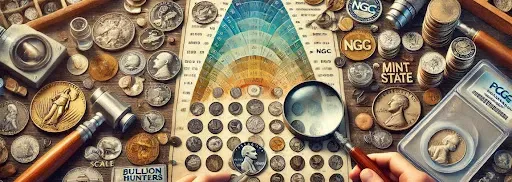
Numismatics, the study and collection of coins, is a hobby that has fascinated enthusiasts for centuries. One of the most critical aspects of coin collecting is understanding coin grading. Coin grading is the process of determining the condition or quality of a coin, which significantly impacts its value. For beginners, grasping the basics of coin grading can be challenging, but it is essential for making informed decisions in the numismatic world. This guide aims to introduce you to the fundamentals of coin grading and help you become a more knowledgeable collector.
The Importance of Coin Grading
Coin grading is crucial because it directly affects the value of a coin. Coins are graded based on their physical condition, including factors such as wear, luster, and overall appearance. A coin in pristine condition is typically worth much more than a coin that shows signs of wear and damage. Professional coin graders use a standardized scale to evaluate coins, ensuring consistency and accuracy in the grading process.
The Sheldon Scale: A Standard for Grading
The most widely used grading system in numismatics is the Sheldon Scale, developed by Dr. William H. Sheldon in 1949. The Sheldon Scale ranges from 1 to 70, with 1 representing a coin that is barely recognizable and 70 representing a perfect, flawless coin. Here is a brief overview of the Sheldon Scale:
- Poor (P-1): A coin that is heavily worn and barely recognizable.
- Fair (FR-2): A coin that is worn but still identifiable.
- About Good (AG-3): A coin with significant wear but more details visible.
- Good (G-4, G-6): A coin with heavy wear, but major details are still clear.
- Very Good (VG-8, VG-10): A coin with moderate to heavy wear, and some finer details visible.
- Fine (F-12, F-15): A coin with moderate wear and significant details visible.
- Very Fine (VF-20, VF-25, VF-30, VF-35): A coin with light to moderate wear and most details still clear.
- Extremely Fine (EF-40, EF-45): A coin with slight wear on high points and all details sharp.
- About Uncirculated (AU-50, AU-53, AU-55, AU-58): A coin with very slight wear on high points and full details.
- Mint State (MS-60 to MS-70): A coin with no wear and ranging from ordinary to flawless.
Factors Influencing Coin Grades
Several factors influence a coin’s grade, including:
- Wear and Tear: The extent of wear on a coin's surface is a primary determinant of its grade. Coins with less wear are graded higher.
- Luster: This refers to the coin's shine, which can diminish over time due to handling and exposure to elements.
- Strike Quality: The sharpness and detail of the coin’s design as originally struck by the mint.
- Eye Appeal: The overall aesthetic appeal of the coin, including color and any visual imperfections.
- Surface Marks: Scratches, dings, or other marks on a coin’s surface can lower its grade.
Professional Coin Grading Services
For beginners, it is often beneficial to have coins graded by professional grading services. These services employ expert graders who use the Sheldon Scale and other tools to accurately assess a coin's condition. Some of the most reputable grading services include:
- Professional Coin Grading Service (PCGS): Known for their rigorous grading standards and secure coin holders.
- Numismatic Guaranty Corporation (NGC): Another highly respected grading service offering accurate and consistent grades.
- American Numismatic Association Certification Service (ANACS): The oldest coin grading service in the U.S., known for grading a wide variety of coins.
- Independent Coin Graders (ICG): A respected service known for their impartial and accurate grading.
How to Start Grading Coins Yourself
While professional grading is essential for high-value coins, learning to grade coins yourself can be rewarding and enhance your numismatic knowledge. Here are some steps to get started:
- Study Grading Guides: Invest in comprehensive coin grading guides and books. These resources provide detailed descriptions and images to help you understand grading standards.
- Examine Coins Closely: Use a magnifying glass or loupe to closely examine the details of your coins. Pay attention to areas that commonly show wear, such as high points in the design.
- Compare with Graded Coins: Compare your coins with professionally graded coins. This will give you a reference point and help you understand subtle differences in grades.
- Practice Consistently: Coin grading is a skill that improves with practice. Regularly examine and grade coins from your collection to build your expertise.
- Join Numismatic Communities: Engage with other collectors and numismatists. Online forums, local clubs, and coin shows are great places to learn and share grading insights.
Common Grading Challenges
Even experienced graders can face challenges when evaluating coins. Some common issues include:
- Cleaning: Coins that have been cleaned often lose their natural luster and may be graded lower.
- Environmental Damage: Exposure to moisture, chemicals, and extreme temperatures can cause discoloration and corrosion, affecting a coin’s grade.
- Counterfeit Coins: Beginners must learn to identify counterfeit coins, which can be difficult to grade accurately.
Conclusion
Understanding coin grading is a fundamental skill for any numismatist. Whether you are a beginner or an experienced collector, knowing how to evaluate the condition of a coin will enhance your appreciation and ensure you make informed decisions. By familiarizing yourself with the Sheldon Scale, studying professional grading standards, and practicing regularly, you can become proficient in coin grading. As you delve deeper into numismatics, this knowledge will not only increase the value of your collection but also enrich your enjoyment of this fascinating hobby.
